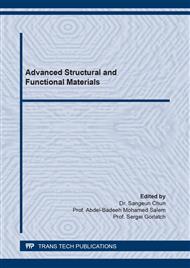[1]
U.S.E.I. Administration, International Energy Outlook 2016, Washington D.C., (2016).
Google Scholar
[2]
A. Jaelani, S. Firdaus, J. Jumena, Renewable Energy Policy in Indonesia : The Qur ' anic Scientific Signals in Islamic Economics Perspective, Munich Per. RePec. Arc. 7(2017)193-204.
Google Scholar
[3]
P. Suharmanto, A.N. Fitria, S. Ghaliyah. Indonesian Geothermal Energy Potential as Source of Alternative Energy Power Plant, KnE Energy 1 (2015) 119–124.
DOI: 10.18502/ken.v1i1.325
Google Scholar
[4]
R.E. Guedes, A.S. Luna, A.R. Torres, Journal of Analytical and Applied Pyrolysis Operating parameters for bio-oil production in biomass pyrolysis : A review, J. Anal. App. Pyro. 129 (2018) 134–149.
DOI: 10.1016/j.jaap.2017.11.019
Google Scholar
[5]
P. Kongnum, S. Ratanawilai, Catalytic Pyrolysis of Coconut Shell for Bio-oil, Int. J. Adv. Chem. Eng. Biological Sci. 1 (2014) 5–8.
Google Scholar
[6]
I. Demiral, A. Eryaz, Bio-oil production from pyrolysis of corncob ( Zea mays L .), Biomass Bioenergy 6 (2011) 1–7.
DOI: 10.1016/j.biombioe.2011.10.045
Google Scholar
[7]
M. Bertero, G. De Puente, U. Sedran, Fuels from bio-oils : Bio-oil production from different residual sources , characterization and thermal conditioning, Fuel 95 (2012) 263–271.
DOI: 10.1016/j.fuel.2011.08.041
Google Scholar
[8]
K.C. Sembiring, N. Rinaldi, S.P. Simanungkalit, Bio-oil from Fast Pyrolysis of Empty Fruit Bunch at Various Temperature, Energy procedia 65 (2015) 162–169.
DOI: 10.1016/j.egypro.2015.01.052
Google Scholar
[9]
D.S. Fardhyanti, B. Triwibowo, H. Istanto, M.K. Anajib, A. Larasati , W. Oktaviani, Liquid phase equilibrium of phenol extraction from bio-oil produced by biomass pyrolysis using thermodynamic models. Chin. J. Chem. Eng. 27 (2019) 391 – 399.
DOI: 10.1016/j.cjche.2018.08.011
Google Scholar
[10]
H. Hajiha, M. Sain, The use of sugarcane bagasse fibres as reinforcements in composites, in: O. Faruk, M. Sain, Biofiber Reinforcements in Composite Materials, Elsevier, Oxford, 2014, p.525–549.
DOI: 10.1533/9781782421276.4.525
Google Scholar
[11]
Sahu, O, Assessment of sugarcane industry: Suitability for production, consumption, and utilization, Annals Agrarian Sci. 16 (2018) 389–395.
DOI: 10.1016/j.aasci.2018.08.001
Google Scholar
[12]
J.M. Mesa-pérez, J. Dilcio, L.A. Barbosa-cortez, M. Penedo-medina, C. Alberto, E. Cascarosa, Fast oxidative pyrolysis of sugar cane straw in a fl uidized bed reactor, Appl. Therm. Eng. 56 (2013) 167–175.
DOI: 10.1016/j.applthermaleng.2013.03.017
Google Scholar
[13]
M.R. Islam, H. Haniu, M.N. Islam, Thermochemical Conversion of Sugarcane Bagasse into Bio-Crude Oils by Fluidized-Bed Pyrolysis Technology, J. Therm. Sci. Tech. 5 (2010) 11–23.
DOI: 10.1299/jtst.5.11
Google Scholar
[14]
D.S. Fardhyanti, B. Triwibowo, H. Prasetiawan, A. Chafidz, Improving the Quality of Bio-Oil Produced from Rice Husk Pyrolysis by Extraction of its Phenolic Compounds, J. Bahan Alam Terbarukan 8 (2019) 90–100.
DOI: 10.15294/jbat.v8i2.22530
Google Scholar
[15]
S.V. Mantilla, P. Gauthier-maradei, P.Á. Gil, S.T. Cárdenas, Comparative study of bio-oil production from sugarcane bagasse and palm empty fruit bunch: Yield optimization and bio-oil characterization, J. Anal. Appl. Pyrolysis 108 (2014) 284 – 294.
DOI: 10.1016/j.jaap.2014.04.003
Google Scholar
[16]
G.J.M. Rocha, A.R. Gonc, B.R. Oliveira, E.G. Olivares, C.E.V. Rossell, Steam explosion pretreatment reproduction and alkaline delignification reactions performed on a pilot scale with sugarcane bagasse for bioethanol production, Ind. Crops. Prod. 35 (2012) 274–279.
DOI: 10.1016/j.indcrop.2011.07.010
Google Scholar
[17]
A. Saddawi, J.M. Jones, A. Williams, Kinetics of the Thermal Decomposition of Biomass, Energ. Fuel 37 (2010) 1274–1282.
Google Scholar
[18]
H. Wijayanti, The Kinetics Study Of Rice Husk Pyrolysis : Studi Kinetika Pirolisis Sekam Padi : Perbandingan Model. Konversi 7 (2018) 35–40.
DOI: 10.20527/k.v7i2.6496
Google Scholar


